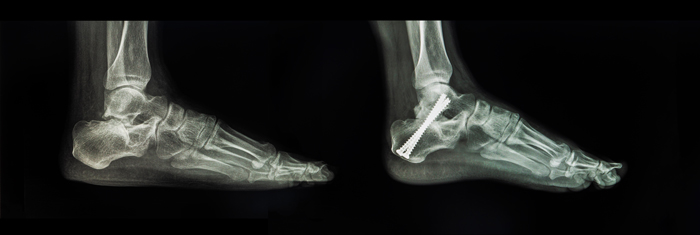Fusion of Joints Treatment & Diagnostics in Sadashiv Peth, Pune
Fusion of Joints
Joint fusion surgery is also known as arthrodesis. This procedure is normally suggested by the doctor to the patient when he/she is suffering from severe foot pain because of arthritis or joint instability. Joint fusion is a process in which the two bones which are causing joint aches are fused or welded together. Thus decreasing the pain and increasing the stability in your joints by fusing the bones to become one solid bone.

Why Fusion of Joints is done?
When a patient is suffering from serious joint pain and he/she has tried non operative methods to lower the pain but is not satisfied by the result, then the doctor recommends joint fusion surgery to reduce the joint pain and increase stability.
Who can have Fusion of Joints done?
Arthritis in a person can damage his/her joints over time and if untreated it can prolong and cause severe damages. Joint fusion surgery is done only after you have tried other treatments and have failed to reduce joint pains.
Joint fusion surgery also helps to mitigate scoliosis and problems like degenerative disks, the surgery can be done on different joints such as:
- Feet
- Fingers
- Ankles
- Spine, etc.
Joint fusion surgery takes a long time to heal, the procedure can take somewhere between 2 to 3 months, joint fusion should be avoided by you if you are having any medical issues such as nervous system problems, suffering from osteoporosis, infections, etc.
When to see a doctor?
If you have severe pain in your foot for a long period of time, you should see a doctor and get yourself diagnosed.
Request an appointment at Apollo Spectra, Pune
Call 1860-500-2244 to book an appointment
What happens during the procedure?
The type of joint fusion operation you need will decide whether you need to go into the hospital and stay after the surgery or have outpatient surgery.
Normally, general anesthesia is given during joint fusion surgery to put you in a controlled state of unconsciousness and relax your muscles. You can also be given local anesthesia instead of general anesthesia where you will be awake but the area of the joint which is to be operated on will be numb.
After the anesthesia, an incision in your skin will be made by the doctor and all the damaged cartilage will be scraped away allowing the bones to fuse.
During the surgery your surgeon will sometimes place a small piece of bone between the ends of your joint, this small piece of bone is taken from your pelvic bone, heel, or from below your knee. If the above process of extracting the small piece of bone is not possible then it will come from a bone bank, where they store bones that are donated and are used for surgeries like this. Instead of an actual bone, artificial bone can also be used which is normally made of special substances.
After this to close the space inside your joint, metal plates, screws and wires will be used which are normally permanent and will be there even after your joint heals. The incision will be closed using staples by your surgeon once the process is done.
Recovery process
The ends of your joints will grow and become one solid bone over time and its movement will be restricted. For this to happen properly, you will need to wear a cast or brace to protect the area. You should also not put any pressure on the operated joint and may have to use a cane, walker, or wheelchair for moving.
After the surgery you might want to take help from your friends or relatives with daily household tasks as the healing process can take about 12 weeks.
Typically, after joint fusion surgery, you will feel stiff and lose range of motion in your joint, physical therapy can help you to keep your other good joints in proper state.
Risks Present in Fusion of Joints
Normally this procedure is safe and doctors tell their patients to opt for it. Still, like any other operation, it comes with some risks and complications such as:
- Bleeding
- Infections
- Nerve damage
- Hardware such as screws, metal plates, and wires can break and get lose causing pain, blood clots, and swelling.
Conclusion
Joint fusion is a process in which the two bones which are causing joint aches are fused or welded together. Thus decreasing the pain and increasing the stability in your joints by fusing the bones to become one solid bone.
Joint fusion is done when you are suffering from serious arthritis and noninvasive treatments have failed to reduce your pain.
Walking just after the surgery is not possible but after few weeks you can walk with the help of a cane or a walker.
Our Top Specialities
NOTICE BOARD
CONTACT US
CONTACT US
 Book Appointment
Book Appointment


.svg)
.svg)
.svg)
.svg)








